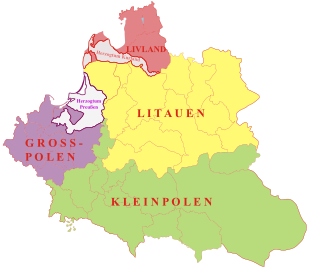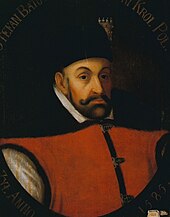Crown Tribunal
The Crown Tribunal or High Tribunal for Greater Poland was the highest court in the Kingdom of Poland , also referred to as the very last instance .
history
The Crown Tribunal ( trybunał koronny ) was established in 1578 in the Polish aristocratic republic by Stephan Báthory and his Chancellor Zamojski in Lublin. The founding of the Crown Tribunal was preceded by a large number of court cases in provincial courts during the so-called roki wielkie (time in which the courts were held) in Greater and Lesser Poland, the legal protection of which was no longer manageable despite royal decrees and resolutions of the Reichstag. At the Crown Court, not only was the actual litigation against the accused, including the interrogation of witnesses, practiced, but judgments were also carried out on the spot. In addition to torture, death sentences were also the order of the day in the 16th century. Both Poles and members of the royal part of Prussia could have their processes carried out here. The latter preferred assessorial courts under German law until 1589 , but had to comply with the decree of King Sigismund III. Wasa and bow to the jurisdiction of the Crown Tribunals.
From 1581, a crown tribunal was also ordered for the Grand Duchy of Lithuania . From 1589 the Lesser Poland Voivodeships of Kiev , Volhynia , Bracław were placed under the jurisdiction of the Crown Tribunal in Greater Poland. The cities, however, were not placed under the jurisdiction of the Crown Tribunal; they retained their own jurisdiction . In addition to secular matters, clerical matters were also negotiated, which, according to a resolution of 1573, were excluded from the process of higher courts. The crown court last met in 1794.
Crown Tribunal in Greater and Lesser Poland (from 1578)
tasks
Mainly the Supreme Court ruled on all criminal matters of the nobility in Poland-Lithuania . In some cases, civil litigation , mainly property matters , was brought before the highest instance, which was usually dealt with before the Grodgericht ( sąd grodowy , District Court of the Starost ) and the Regional Court ( judicium terrestre ). The tribunal met annually, sometimes over several months or an entire year.
The tribunal in Greater and Lesser Poland comprised register matters from 1776 under the following number:
- I. palatinatuum,
- II. Expulsionum,
- III ordinationis Zamorscianae,
- IV. Remissionum,
- V. terminorum tactorum et violatae securitatis,
- VI. incaceratorum,
- VII. Directi mandati,
- VIII. Exicutionum processuum,
- IX. poenalium,
- X. causarum ecclesiastricarum | mixti
- XI. paritatis votorum.
However, many tribunal decrees recognized the diets of the aristocratic republic of Poland-Lithuania as ineffective, as it was feared that the crown tribunals could claim their affairs for themselves. Often times less than 10% of all judgments of the tribunals were carried out. Most of the judgments were overturned or modified by the Reichstag.
composition
The tribunal was composed of representatives of the people, nobles from the voivodships and clergymen from cathedral chapters . At first there were spiritual representatives from the chapters Gnesen , Cracow , Włocławek , Posen , Płock , Łuck , Chełm , Kiev and the Diocese of Kamieniec . The secular representatives initially provided 21 jury members with voting rights, who were excluded from voting in legal matters of their own voivodships. They later had more than 30 MPs. Decisions and votes were made with a simple majority.
Clergymen
Before a tribunal or court day, the cathedral chapters elected members from among their ranks; these could be both abbots and full members of a chapter, who were consequently sent to the tribunal. The Poznan Cathedral Chapter regularly provided the chairman of the clergymen or judges at the tribunal in Greater Poland with its castellan. The chairman of the clergymen at the tribunal in Lesser Poland was the castellan or canon of Gniezno.
Secular MPs
The secular judges in the tribunal were made up of nobles from the aristocratic republic , who were always chosen on July 15 of each year at a specially held state parliament. Each voivodeship had a representative, also known as a magnate . The representatives could be elected or proposed at the request of the voivode . Representatives of the respective provinces took turns chairing each year from their ranks. The chairman was elected by the secular representatives before each tribunal. In addition to aristocratic descent, the prerequisites for election in the 18th century were integrity as well as unencumbered, up to a maximum of half pledged property in the voivodships for which they were eligible. In addition, they had to be at least 30 years of age, be in service and be familiar with the legal system; The latter was rarely the case at the beginning of the Crown Tribunal. Corresponding envoys or members of parliament were sworn in by their state parliaments. The MPs were only able to be re-elected after six years.
Chair
The chairmanship was held at the same time by the representatives from the ranks of the clerical deputies (president) and the representatives of the secular deputies (also known as marshal). Nobles from Greater and Lesser Poland took turns chairing the meeting. In contrast to the jury, who often only stayed briefly at the trials, the chairmen were rewarded princely. The spiritual chairman, who, in contrast to his secular representative, was also allowed to vote in secular matters, received a salary of 10,000 guilders, the secular even 20,000 guilders for his services. Especially at the beginning of the 18th century, the chairmen had to ensure that no one from their classes discussed, influenced or even bought votes before or during the tribunal. At times the delegates were not allowed to negotiate contracts or conduct business during the time of the Tribunal. Corresponding attempts had to be reported immediately by those involved; failure to do so was a punishable offense from which even the chairpersons were not exempted. Entertainments or celebrations at the place of residence of the tribunate and their entourage were also punishable by the deputies. In the past, it was not uncommon for gatherings with drinking bouts or even scuffles by secular representatives and their entourage to get out of hand, or even for chaos to break out at the seat of the tribunal, as convicts and their relatives tried with all means to influence the decision of the judges and jury . From the second half of the 18th century, the marshals could be re-elected as representatives every four years.
protocol
The protocol of the tribunate was kept by a notary or land clerk. This had to deal exclusively with the course of the tribunate and was presented annually by a different voivodeship.
Court seat
The court has met in Lublin since the Crown Tribunal was founded in 1578 . As a result, each magnate family later acquired an aristocratic residence or palace there or had it built there. In the same year a cadence (time of the crown courts) was also held in Peterkau . As a result, the court was supposed to sit in Lublin from September 1st of each year, where matters from Lesser Poland were dealt with. From Monday after Easter Sunday the Crown Tribunal met in Peterkau ( Piotrków ) on matters relating to Greater Poland.
Crown Tribunal in the Grand Duchy of Lithuania (from 1581)
The Crown Tribunal in Lithuania was organized analogously to the tribunal in Greater and Lesser Poland. It took place over five months in Wilno and Grodno . The secular deputies consisted of 49 nobles, the clerical six people. In contrast to the tribunal in Greater and Lesser Poland, the Lithuanian Crown Tribunal only comprised five registers.
Well-known representatives
|
See also
literature
- Collection of judicial laws for the Kingdom of Poland and the Grand Duchy of Litthauen, according to the Imperial Constitution of 1776. Von Personen, Volume 1, 1780, pp. 37-43 ( digitized version ).
- Siegfried Hüppe: Constitution of the Republic of Poland. BoD - Book-on-Demand , 2012, p. 290 ff. ( Digitized version ).
Web links
- State Archives in Lublin
- Trybunał Główny Koronny 1578–1649 in Leksykon Lublin
Individual evidence
- ^ Karl Hammerdörfer, Christian Traugott Kosche: Europe: a geographical-historical reading book for the benefit of young people and their educators. Northern and Eastern Europe. Volume 2, 1785, p. 393.
- ^ Wacław Alexander Maciejowski: Slavic legal history, trans. by FJ Buss and by M. Nawrocki, and accompanied by notes by the former. 1835, p. 85.
- ↑ Christoph Hartknoch: Old and New Prussia. 1684, p. 636.
- ^ Friedrich Wilhelm Ferdinand Schmitt: The Flatow district: in its entire relationship. 1867, p. 139.
- ↑ Johann Heinrich Seyfried: Poliologia, which is famous description of all cities in the world. 1683, p. 313.
- ↑ Christian Gottlieb Jöcher : Continued new genealogical-historical news of the most distinguished events that happened at the European courts. Volume 7, 1768, p. 577.
- ↑ As before. P. 577.
- ↑ Christian Gottlieb Jöcher : General learned lexicon. 1813, p. 212.






